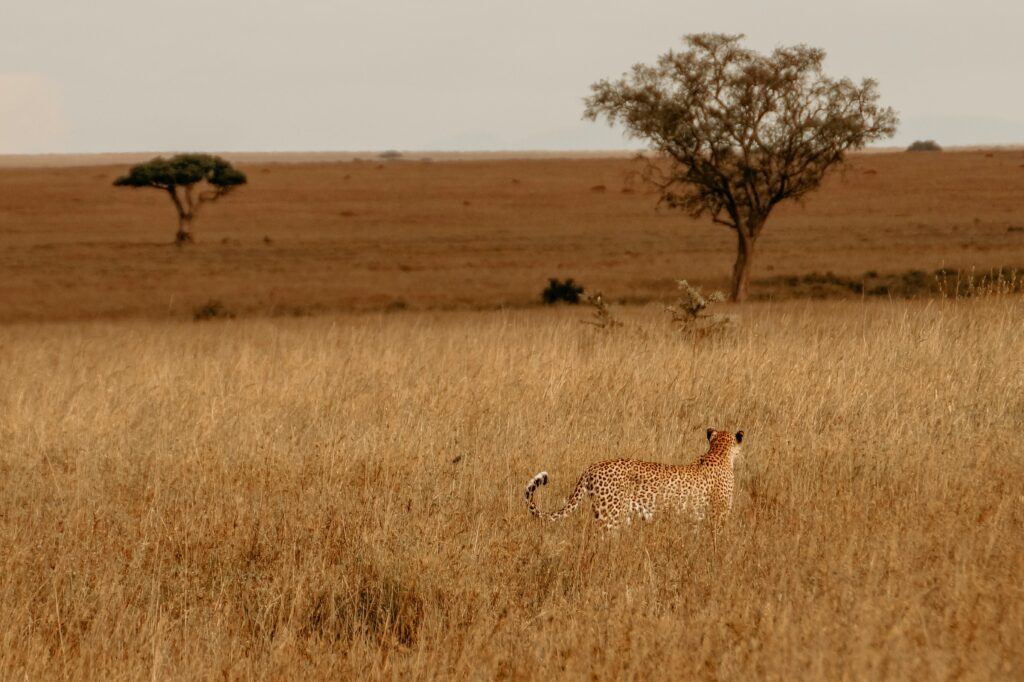Savanna Peak

Animal Instinct
Summer on the savanna is not gentle. It’s bold, loud, and filled with tension. The grasses are tall, golden, and whispering in the heat. Dust lifts with every hoofbeat. The sky is sharp and white. This is the peak — when life is fully visible, fully active, and running on instinct.
Predators are on the move. Lions lie in the shade during the hottest hours, but at dawn and dusk, they stretch, stalk, and strike. Cheetahs use the long daylight to scan open plains, sprinting with deadly silence. Leopards move through the treetops or slink along the riverbanks, slipping between shadow and light.
Herds gather near the shrinking waterholes. Zebra, wildebeest, gazelle — constantly grazing, constantly alert. Elephants arrive in small matriarchal groups, their calves caked in mud, their trunks reaching for the last green branches. Giraffes feed high above the competition. Buffalo stir the ground with heavy steps. The savanna is crowded — not with chaos, but with balance that shifts by the hour.
Birds flash through the air, weaving between herds and trees. Oxpeckers cling to hippos and rhinos, cleaning as they go. Secretary birds pace through the grass with heads high and deadly feet ready. Vultures circle — not always waiting, sometimes watching.
And under it all: insects, reptiles, scavengers. The unsung engine of the ecosystem. Dung beetles working in the shadows. Monitor lizards basking and lurking. Termites building heat-regulated towers below the surface. Nothing is idle. Nothing is still.
For wildlife watchers and photographers, this is a time of abundance — but also of intensity. The heat presses down. The animals are exposed. The behaviors are sharper. Survival is on display. The savanna in summer doesn’t hide anything. It offers the full picture — strength, struggle, and everything in between.
You don’t need to search hard. In the savanna peak, nature comes to you. You just have to be ready.
Predators are on the move. Lions lie in the shade during the hottest hours, but at dawn and dusk, they stretch, stalk, and strike. Cheetahs use the long daylight to scan open plains, sprinting with deadly silence. Leopards move through the treetops or slink along the riverbanks, slipping between shadow and light.
Herds gather near the shrinking waterholes. Zebra, wildebeest, gazelle — constantly grazing, constantly alert. Elephants arrive in small matriarchal groups, their calves caked in mud, their trunks reaching for the last green branches. Giraffes feed high above the competition. Buffalo stir the ground with heavy steps. The savanna is crowded — not with chaos, but with balance that shifts by the hour.
Birds flash through the air, weaving between herds and trees. Oxpeckers cling to hippos and rhinos, cleaning as they go. Secretary birds pace through the grass with heads high and deadly feet ready. Vultures circle — not always waiting, sometimes watching.
And under it all: insects, reptiles, scavengers. The unsung engine of the ecosystem. Dung beetles working in the shadows. Monitor lizards basking and lurking. Termites building heat-regulated towers below the surface. Nothing is idle. Nothing is still.
For wildlife watchers and photographers, this is a time of abundance — but also of intensity. The heat presses down. The animals are exposed. The behaviors are sharper. Survival is on display. The savanna in summer doesn’t hide anything. It offers the full picture — strength, struggle, and everything in between.
You don’t need to search hard. In the savanna peak, nature comes to you. You just have to be ready.
